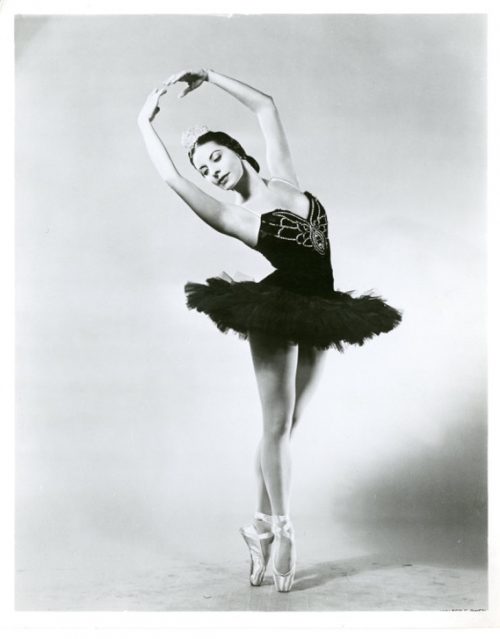
BY JUDY CARMACK BROSS
Rare footage of darned toe shoes once worn by Anna Pavlova, a captain’s chair used by Maria Tallchief to direct her company, photos of a hometown girl who danced with a Turkish troupe on the Midway during the World’s Fair of 1893, the legendary Ruth Page at age 13 with fairy wings, and other treasures will be brought from the Newberry Library’s vault next year for an exhibition showcasing the most extensive collection of dance in the Midwest. Alison Hinderliter Manuscripts and Archives Librarian, previewed the magic of their collection for us.
“Our collections of dance in Chicago begin in the 1890s. We have over 80 archives of dancers, dance critics, dance groups, photographers, schools and studios, and dance advocacy organizations. The keystone is the vast collection of preeminent dance critic Ann Barzel. For 90 years Ann had a passion for collecting anything and everything related to dance in Chicago, including rare films of performers, and she gets credit for putting Chicago on the map as a major dance center.
“When she was still alive, she would bring perspective donors by to see our collection, and then suddenly we would have their clippings, programs and all sorts of records. Almost every international dancer of note came through Chicago, and Ann captured most on film.
“Often their careers were interrelated. A teenaged Ruth Page toured with Pavlova. Gene Kelly studied classical ballet here briefly in the 1930s with Berenice Holmes, and Ann Barzel was also in the class. We have his 1947 letter requesting that Ann send him as many of the films as possible, which he viewed as he choreographed American in Paris and other movies.”
Some of the films that Ann Barzel shot from just beyond stage sightlines of visiting ballet companies will be part of the 2019 Newberry exhibition. Barzel said that her life began at nine when she first looked up the word ‘dance’ in the encyclopedia. When she died at 101, the Newberry had 30,000 feet of her films as a legacy. One of the most fascinating film clips shows an early performance by Martha Graham and Merce Cunningham. “All the books in the world can never tell you how Nijinsky danced” Ann was known to say about her films.
Martha Briggs, Lloyd Lewis Curator of Modern Manuscripts and the upcoming show’s curator, explained:
“Our 2019 exhibition will emphasize the visual, especially photographs and films, to tell the story of Chicago’s creative, vibrant, and diverse community of dancers, dance companies, and dance educators over the 20th century.
“We also want to trace some of the DNA of Chicago dance by digging into the library’s collection of European and early American dance treatises and chronicles, instruction books and manuals, and choreography and notation books.
“The Newberry hasn’t had a dance exhibition in over twenty years, and the collection has grown tremendously since then. We are so pleased to be able to show new materials to a new generation of exhibit-goers in the library’s newly renovated exhibition space.”
It is the toe shoes of Anna Pavlova; Alicia Alonso, ballerina and founder of The Ballet Nacional de Cuba, who is represented by the shoes she used in Giselle here in 1980; and Dame Margot Fonteyn, named Prima Ballerina Assoluta by Queen Elizabeth, that tell of a dancers life. Anna Pavlova’s tiny shoes have been repaired several times over.

Alicia Alonso of American Ballet Theatre in the role of the Giselle, 1940s. Ann Barzel Dance Research Collection, The Newberry Library, Chicago.
The collections feature almost every type of dance, and some of the most wonderful photos include those of Christina Olson, the 12-year-old Chicago dancer who performed at the Turkish Theater on the Midway at the World’s Columbian Exposition. In addition to photos of Christina in exotic costumes, her music degree from the Chicago Conservatory and rare World’s Fair souvenirs are included in the collection.

Cover of the Turkish Theatre brochure. The Turkish Theatre was on the Midway Plaisance of Chicago’s World’s Columbian Exposition of 1893. Christina Olson Papers, The Newberry Library, Chicago.

Photograph of dancer Christina Olson and World’s Fair pass, 1893. Christina Olson Papers, The Newberry Library, Chicago.
The Newberry also has the extensive collection featuring Dorothy Hild, Director of Entertainment at the Edgewater Beach Hotel and founder of the dance troupe Africana Dancers. She often staged circus parades with her dancers riding on camels and tied bells to dancers’ ankles when they performed holiday songs.

Choreographer Dorothy Hild, seated on camel on Chicago’s lakefront, 1968. Dorothy Hild Papers, The Newberry Library, Chicago.
Alison, herself an amateur dancer who has studied Bharatanatyam and belly dancing, described what dancers seem to have in common:
“They are so passionate about their work, no matter what the style of dance is. Actors and singers are in much more forgiving areas of entertainment. A dancer might be able to perform until 40 if she is lucky. A lot of dancers are very savvy and want to find ways to stay in the dance world. They become dance administrators, teachers, or begin their own companies.
“We are working closely with Stephanie Clemens of Oak Park, who is devoted to perpetuating the legacy of Oak Park-born choreographer Doris Humphrey, a contemporary of Isadora Duncan. Ms. Clemens also has her own dance company called Momenta! She is a remarkable dance administrator and leader who, despite the aches and pains of a long career, is working on making dance more accessible by offering therapeutic dance as well as classes for those with limited mobility.”
Ballet Russe de Monte Carlo star, America’s first prima ballerina, and beloved Chicagoan, Maria Tallchief Paschen is represented by a director’s chair bearing her name, which she used when she led the Chicago City Ballet in the 1980s.
Recent collections that have been organized include extensive Hubbard Street photos; archives of Lakeview’s MoMing Troupe, which closed in the early 1990s; and the photo archive of noted dance photographer William Frederking.
Among Alison’s favorites in the collection are souvenir books from the 1930s through the 1950s that one could purchase at the theaters when the companies performed: “There are so many glamorous shots of not only the dancers but of the companies on tour and behind the scenes. The ones of the Ballet Russe are incredible.”
Many of the collections received by the Newberry have arrived in disarray, often stored in a member of a troupe’s storage space, long forgotten. The Donnelley Foundation recently awarded a two-year grant to archive Chicago dance treasures as preparing treasures for the exhibition requires many staff hours. Alison noted:
“Thanks to the Donnelley Foundation’s grant, we were able to hire an extra archivist to help the archives team go through, sort, arrange, and describe our largest unprocessed dance collections. Through the Newberry’s website, we can now make them much more accessible to the public with descriptive online inventories.
“We are already reaping the benefits from this work with increased use by researchers near and far. In addition, we’ve also been able to get a lot of audiovisual materials digitized so that people can view films and listen to audio in our reading room.”
***
For more about current and upcoming exhibitions at the Newberry Library (60 West Walton), visit newberry.org.
















